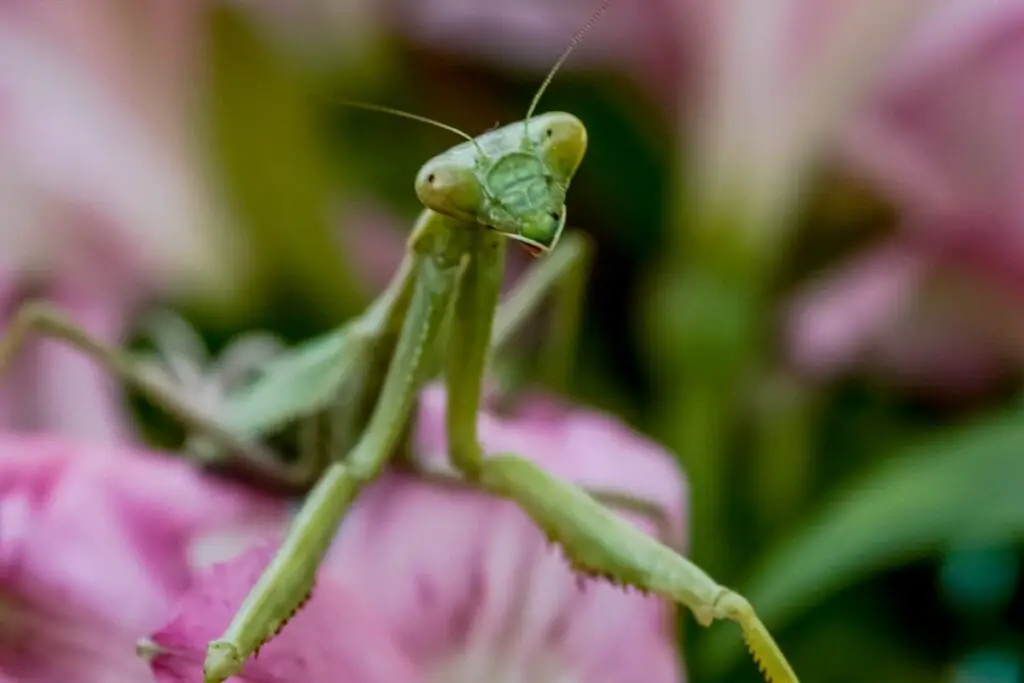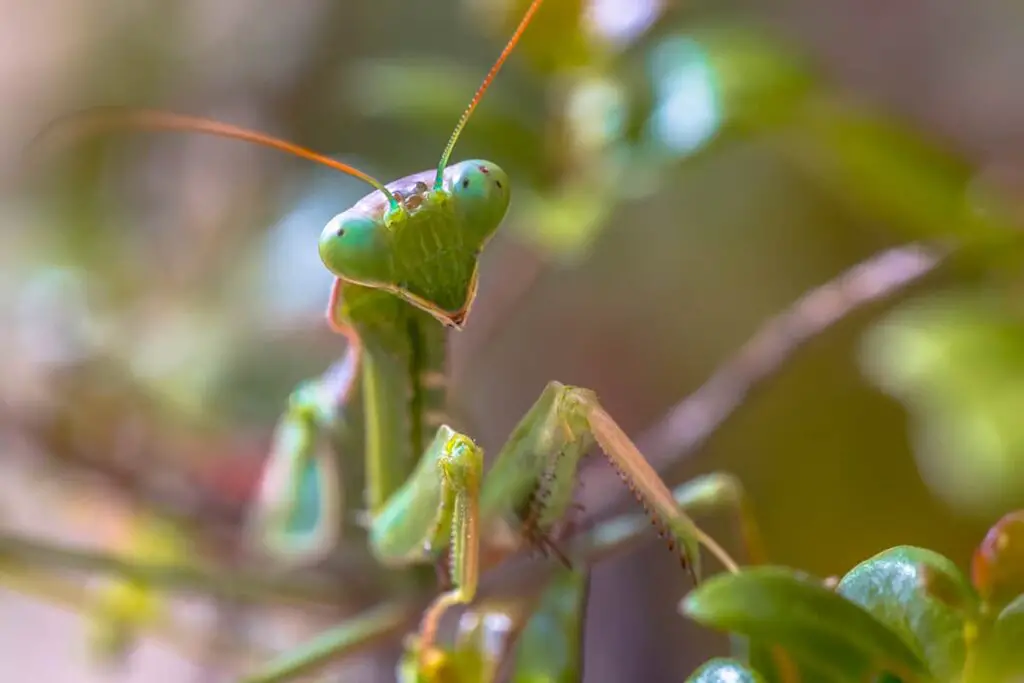Keeping a praying mantis as a pet is a unique and fascinating experience, offering a window into the intricate world of these predatory insects. If you’re new to mantis care, understanding what and how to feed your mantis is crucial. These insects are carnivorous and require live prey. The variety of suitable live food includes fruit flies for young or small species and larger insects like crickets, moths, and even roaches for adults.
Knowing the right feeding techniques and schedules will help your praying mantis thrive. Maintaining a consistent supply of appropriate insects is essential. It’s equally important to observe your mantis during feeding, ensuring that the prey is not too large or too aggressive, which could cause injury to your pet.
As you embark on this journey of mantis pet care, remember to keep the size and species of your praying mantis in mind, as these factors will influence their diet and how often they need to eat. For instance, a Chinese Praying Mantis might require a different feeding regime compared to an African Praying Mantis. Care and attentiveness to your praying mantis’s needs will ensure a rewarding experience for both you and your tiny predator.
Understanding Mantis Species
When starting your journey with praying mantises, it’s crucial to recognize the differences between species and understand their unique dietary requirements.
Identifying Common Mantis Types
- Hierodula membranacea: Known as the giant Asian mantis, they are one of the larger species suitable for beginners, with adults reaching up to 10 cm in body length.
- European Mantis (Mantis religiosa): Often found in temperate areas, they showcase a classic mantis appearance and moderate size.
- African Mantis (Sphodromantis lineola): Another beginner-friendly species, they are known for their aggressive feeding habits and larger size.
Species-Specific Nutritional Needs
-
Hierodula membranacea: This species has a voracious appetite, preying on a variety of live insects, including flies, moths, and even smaller mantises if food is scarce.
Nutritional Profile:
Nutrient Requirement Protein High – from live insects Carbohydrates Minimal Fats Moderate Vitamins Sufficient from prey -
Mantis religiosa and Sphodromantis lineola: Both species thrive on a similar diet composed mainly of live insects, but portions and frequency may vary with size and lifecycle stages.
Preparing for Mantis Care
Before bringing a praying mantis into your home, it’s crucial to set up a proper habitat and have the right feeding equipment ready to ensure your new pet thrives.
Setting Up the Habitat
Your praying mantis will need a home that mimics its natural environment as closely as possible. A cage that’s at least three times the length of your mantis and twice the width will provide sufficient space for it to move around. Ensure good ventilation with a secure, screened lid. For substrate, consider a moisture-absorbing option like soil or coco coir, but remember to sterilize it to eliminate any contaminants. Your mantis will thrive in an environment that maintains the appropriate temperature and humidity, both of which are species-specific, so research the needs of your particular mantis species.
Choosing the Right Feeding Equipment
When it comes to feeding your mantis, having the right equipment is key. You’ll mainly need a spray bottle for misting and a variety of feeders such as fruit flies, crickets, or other small insects for your mantis to hunt. It’s essential to feed mantises live prey as they’re stimulated by the movement. Keep the prey items appropriate to the size of your mantis to prevent any potential harm. Proper nutrition is vital, so consider gut-loading the prey to ensure a nutrient-rich diet for your mantis.
Feeding Your Mantis
When you decide to keep a praying mantis as a pet, understanding what they eat and how to feed them properly is crucial for their health and well-being.
Live Prey Selection
Your mantis thrives on a diet of live insects. It’s important to choose prey that is suitable for the size of your mantis. For a juvenile mantis, fruit flies or small crickets are ideal. As your mantis grows, you can graduate to larger prey like houseflies or roaches. Ensure the insects are not bigger than the head of your mantis, as larger prey can cause harm to your pet.
- Small Mantis:
- Fruit flies
- Pinhead crickets
- Large Mantis:
- Houseflies
- Roaches
- Moths
It’s also important to provide variety in your mantis’s diet. This not only helps to ensure a balance of nutrients but also keeps feeding time interesting for your pet. For more details on prey selection, learn about the variety of insects suited for mantises at Beginners Guide on Keeping Praying Mantis as Pets.
Feeding Schedule and Techniques
Frequency of feeding is dependent on the age and species of your mantis. Generally, nymphs (young mantises) should be fed daily, whereas adults can be fed every other day or, depending on the species, possibly twice to three times a week.
| Mantis Stage | Feeding Frequency |
|---|---|
| Nymph | Once a day |
| Adult | Every other day / 2-3 times a week |
To feed your mantis, gently place the live insects into the enclosure. It’s best to use tweezers to avoid stressing your mantis. Additionally, you can use a spray bottle to lightly mist the enclosure, not only to provide hydration but also to stimulate the hunting instinct of the mantis. Keep an eye on the quantity of food consumed; overfeeding can be as harmful as underfeeding. For insights into feeding techniques and schedules, a resourceful guide can be found here: A Beginners Guide to Keeping Praying Mantis as a Pet.
Health and Nutrition
Proper nutrition is crucial for your mantis’s health, so it’s important to understand how diet impacts their well-being. Let’s explore how you can monitor their health and tailor their diet for optimal nutrition.
Monitoring Mantis Health
To ensure your mantis remains healthy, check for signs of vitality such as an active demeanor and a responsive attitude to stimuli. A healthy mantis will also exhibit regular molting and should have a strong grip. Keep an eye out for any changes in these behaviors, as they can indicate potential health issues.
Supplementing Mantis Diet
While mantises typically feast on a variety of insects, supplementing their diet with calcium and vitamins can promote healthier exoskeletons and overall well-being. Supply these nutrients by dusting prey with a specialized supplement powder every few feedings. Additionally, offering a variety in their diet can prevent nutritional deficiencies.
Remember, a balanced diet affects the lifespan and vitality of your praying mantis, and observing their behavior can provide insight into their health status.
Frequently Asked Questions
In this section, you will find the answers to some common questions about mantis feeding. Whether you are a beginner or just looking to improve your feeding techniques, these insights will help you provide the best care for your mantis.
How often should I feed my pet mantis?
Your pet mantis’s feeding frequency largely depends on its age and size. In general, nymphs should be fed every day, whereas adults may only require feeding every 2-3 days. Monitor your mantis’s activity and adjust as necessary.
What is the best diet for a green praying mantis?
The best diet for a green praying mantis is a variety of live insects such as flies, crickets, or moths. These insects should not be more than half the size of the mantis to ensure they can be consumed without difficulty.
Are there any special requirements for feeding large mantis species?
Larger mantis species might be able to handle bigger prey, such as larger crickets or even small vertebrates, but it is important to feed them prey not larger than half their body size to prevent injury or escape of the prey.
What are some tips for feeding a praying mantis for beginners?
For beginners, it’s recommended to start with smaller prey items and gradually increase the size as your praying mantis grows. Ensure the prey is alive to stimulate the mantis’s hunting instinct, and remove uneaten prey after 24 hours to maintain a clean habitat.
Can a pet praying mantis eat honey, and how should it be offered?
Praying mantises can eat honey, but it should be offered in moderation as a treat. Place a small droplet on the tip of a toothpick and allow your mantis to lick it off as a way to supplement its diet.
What signs indicate that I might be overfeeding my praying mantis?
Signs of overfeeding include a disinterest in food, a visibly bloated abdomen, or excrement that seems more frequent or larger in volume than usual. If you notice these signs, scale back the feeding frequency or quantity.
Driven by a passion for those tiny creatures that rule our world, we at Bug Domain strive to be your go-to resource for information on insects.



